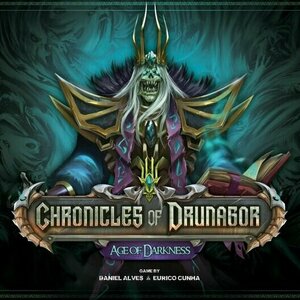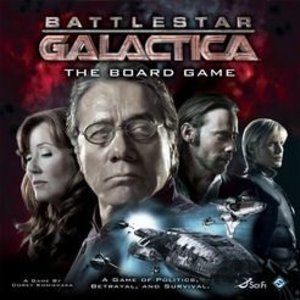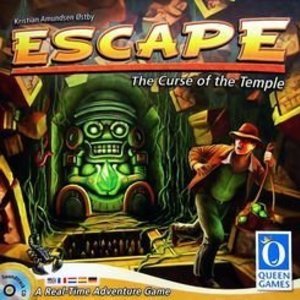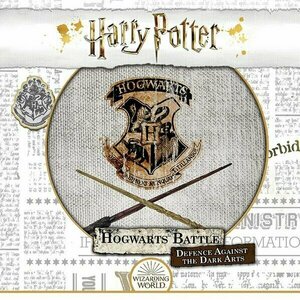Like I just mentioned, Defence pits two players against each other in a sparring scenario. Players will be drafting cards that represent Spells to sling, Allies to aid, and Items to help knock opponents off their balance. The winner of Defence is the wizard who can stun their opponent three times. Only then will they be able to stand a chance against their dark foes.
DISCLAIMER: We were provided a copy of this game for the purposes of this review. This is a retail copy of the game, so what you see in these photos is exactly what would be received in your box. I do not intend to cover every single rule included in the rulebook, but will describe the overall game flow and major rule set so that our readers may get a sense of how the game plays. For more in depth rules, you may purchase a copy online or from your FLGS. -T
To setup a game, follow the rulebook instructions to lay out the main duel board and its shuffled decks that will surround it. These include the Hogwarts deck (from which players will be purchasing cards to add to their discard piles), the Library deck (which includes only Books cards that add influence or the ability to draw the top card of the player deck), Hexes (which are placed directly in the opponent’s discard pile and must be dealt with first when in hand), and Banished cards. Each player will choose a House card and a matching mover token to be placed on the board. Likewise, each player will have a starting hand of seven Alohomora! cards, one Wand, one Cauldron, and one starter Ally: Owl, Toad, or Cat. Each player will shuffle their starting deck, drawing five for their starting hand. Determine the starting player and the duel may begin!
On a player’s turn they will first deal with any Hex cards they have acquired, following the instructions written on the card. Once cleared, the active player will play cards from their hand in any order they wish to gain Influence to purchase cards from the Classroom (market), Attack points to push back their opponent towards the Stun space, or Health points to move their own mover token one space closer to the Starting space on the board.
Cards that are purchased from the Classroom can be Items, Spells, or even Allies. Items and Spells typically provide Influence, Health, or Attack, and some will have House bonuses in addition to normal effects. In order to take advantage of the House bonus, a player will either need to be from the affiliated House, or have an active Ally belonging to the affiliated House. This is a new mechanic in this game and adds another layer of strategy to a player’s purchasing.
As wizards duel back and forth slinging Spells, recruiting and activating Allies, and using Items to push back their opponent, one wizard will be stunned. When this happens the players will reset their play areas by combining all of their cards they have in their possession. Shuffle the lot of them, draw another hand of five cards and reset their mover token back to the Starting space. The next round is ready to begin and the wizard who stuns their opponent thrice will be crowned champion! Or get an A for the day… or whatever the Common Core equivalent is nowadays.
Components. I have many great things to say about the components in this box and a couple little gripes. Gripelets, really. First gripe: the box comes with a cardstock sleeve. It is very cool and looks great, but it’s unnecessary and I find it keeps snagging on other boxes and such. Not a big deal, as I can always get rid of it, but that’s an opinion. Second, the board is very dark. It features a very dark purple (yay purple!) with black spaces upon which players move their tokens. The colors are very close under certain lighting and I wish there was even just a faint outline of the spaces in a white or gray. Lastly, and probably just me and the way I play, the Attack and Health trackers are almost completely unnecessary. I know you are supposed to take a token every time you “Gain” a Health or Attack point, but I always just keep track in my head thus negating the need for the tokens.
But onto the great. Literally everything else is great. I have always enjoyed the components in the original game, and as this one contains many of the same, I also enjoy these. The art style is interesting and pretty cool, and I really don’t mind screencaps as much as many others do. So for me, overall, I really enjoy the components here.
All in all I truly love this game. I am almost always in the mood to play Harry Potter: Hogwarts Battle, but it is cooperative and my wife doesn’t really enjoy the OG HP game. This one, however, she does enjoy because she can just flex on me and stun me into oblivion with her superior deckbuilding abilities. This one is quicker to setup and play, and holds a much smaller footprint. The mechanics are familiar without being totally duplicating, and I just love deckbuilders in general. So this one was bound to be a big hit with me from the start.
If you are looking for a great Harry Potter-themed deckbuilding game and are not completely sold on the bigger cooperative game, take a look at this much smaller two-player competitive title. Do try to take some of the cards with a grain of salt, as I am sure it is difficult to imagine having both Hermione and Draco as allies simultaneously, but it can happen in the game. Purple Phoenix Games gives this one a very enthusiastic 11 / 12. Just a word of caution, try not to Flipendo your table when you lose. It won’t end well.
Purple Phoenix Games (2266 KP) rated YOHO (You Only Hang Once) in Tabletop Games
Jan 14, 2021
As mentioned previously, YOHO is a semi-cooperative game of pirate players attempting to find the Treasure and bury it in their safe spaces by the end of the game. Players will be assuming roles of jobs on a pirate ship: Captain, Quartermaster, Bosun, Seadog, and Pariah. These positions have jobs and pirating to do or else they may find themselves walking the plank.
DISCLAIMER: We were provided a copy of this game for the purposes of this review. This is a retail copy of the game, so what you see in these photos is exactly what would be received in your box. I do not intend to cover every single rule included in the rulebook, but will describe the overall game flow and major rule set so that our readers may get a sense of how the game plays. For more in depth rules, you may purchase a copy online or from your FLGS. -T
To setup players will choose their pirate persona and place it in front of them with the Loyal side showing. On the backside is the Rebel side, which will allow the player special abilities later in the game. A Captain is chosen and that player then doles out the remaining ranks of pirate jobs to the other players. Each player will be dealt five cards from the shuffled Blame deck (draw deck) for their starting hands. The top card from the deck is flipped to become the Blame Pile (discards). The Captain takes the Course card and places it Port side up. The game may now begin!
The active player’s turn will be comprised of four steps. The first step is refilling the hand to five cards. Should the player have more than five then no additional cards are drawn. Next the player will choose one card from hand to play to the Blame Pile. The card may not contain the same text as the card below it, so no stacking UNO Draw 2s. Once the card is played to the Blame Pile the active player will carry out the card’s instructions. These could be switching hands with other players, flipping their pirate cards to Rebel or vice versa to Loyal, Demoting pirate ranks, or one of the other four actions printed on the cards. Finally the active player passes the Course card to the next player to take their turn.
While this all seems typical of many card games, YOHO forks from the common by employing a Blame mechanic. One of the aforementioned other actions on cards is the Accuse action. When one player accuses another the Blame Pile is consulted, and whichever pirate’s rank number matches the highest sum of the matching rank number of cards in the Blame will take the entirety of the Blame Pile into their hand. For example, if the Bosun (3) accuses the Seadog (2) then the Blame Pile is sifted through in order to see how many cards match the 2 and 3 of the ranks involved. Add up the totals of these cards to arrive at the rank’s Blame. The larger number receives the Blame. Special rules are provided for when the Captain is both involved in an accusation and also when the Captain is forced to take the Blame.
The game ends once a pirate draws the last card from the Blame (draw) deck. Players will total their matching Blame in their hands, adjust this number if the player holds the Treasure card or if the pirate is Loyal vs. Rebel according to the Course card’s current display. The player with the most Blame will walk the plank and lose immediately. With a few other scoring rules the player still on board with the highest rank wins!
Components. This game is a deck of cards in a tuckbox. The cards are all fine quality with linen finish (the best finish methinks). The art is somewhat cartoony, but still enjoyable and not offensive at all. I don’t have any problems with the components in YOHO.
My first game of YOHO was played between my wife and I and it was a disaster. I strongly suggest playing with three or four, with four giving the best experience. When the full compliment is used there is only one “inactive” pirate who sits in the middle of the table holding onto their rank and not really doing anything. A ghost player, if you will. However, with two players there are three ghost players not doing anything. It just didn’t work with us AT ALL. But four players was quite enjoyable and actually saved this one for me.
I like the gameplay here. It is different and quirky, and I like that. The constantly-shifting ranks and demotions left and right makes players wish for promotions, but those only come as demotions to a higher rank. Also being able to accuse other players caters to the card counters in the group because they can be watching which cards are played to the Blame Pile and know exactly which rank has more cards represented. While that is dependent on the type of players involved, I have not found that to be a problem. I also really like the shifting Course card. When on Port all pirates can do their jobs, but as soon as it flips to Starboard the Rebel pirates may NOT complete their jobs. This is such an interesting way to utilize the active player token instead of just noting which player’s turn it is currently.
Again, I do NOT recommend playing with two, but definitely do recommend with four. I would be hesitant at three, but it can certainly work. Purple Phoenix Games gives this one a wishy-washy-swashbuckling 8 / 12. If your collection is missing another pirate card game that can be played quickly, has interesting twists, and fresh-feeling mechanics, give YOHO a try. You might finally have the chance to send your rival off the plank. But be warned, despite the title, there is no hanging in YOHO (You Only Hang Once).
Purple Phoenix Games (2266 KP) rated Kim-Joy's Magic Bakery in Tabletop Games
Apr 8, 2022
Kim-Joy’s Magic Bakery is a cooperative hand management scenario-based card game for two to five players. In it, players are employees of the Magic Bakery and are tasked with baking wondrous items to satisfy a group of customers requesting their favourite (it’s British, I’m just doing my part) dishes. The game ends once all customers have been served or are otherwise no longer in the game. Depending on the current scenario, the group scores points based on how many customers they were able to serve. All players win together or they do not win.
Setup the Customers card deck according to the number of players, shuffle them, and deal out one or two (depending on number of players as well) face up to the table to begin the Customer Row. Do NOT shuffle the Layers cards. Instead, separate them by type and place them all face-up in decks by type. Do shuffle the yellow Ingredients cards and place out five face up (or face down depending on scenario) to form the Pantry Row. Each player draws a starting hand of three Ingredient cards from the deck, and the starting player takes the Kim-Joy standee to begin!
On a turn, the active player will have choices of actions to be taken, in any order they choose, from among the following: take an Ingredient card, pass a card to another player, bake a Layer, fulfill a Customer order, or refresh the Pantry. Depending on the number of players, each turn will consist of either two or three actions being taken. Most actions are self-explanatory, but I will give a quick hit to them all. The active player may see an interesting Ingredient card in the offer row and may simply draw it into their hand for an action. Once the player has enough Ingredients to bake a Layer (by discarding the requisite Ingredient cards) they may do so for an action. If the player has a card they believe another player could utilize, they may simply pass them that card as an action – either Ingredient or Layer. The goal of the game is help fulfill customer orders, so by using an action to fulfill an order, the player discards all the necessary cards and helps the group inch one step closer to victory. At a loss and need a suggestion for an action? Discard all cards from the Ingredient Row and draw new ones.
Once each player has completed their actions, the Customer Row is shifted one space to the right and a new Customer comes into the bakery. The bakery can only accommodate three customers, so if a new hungry Customer visits, they force out the Customer who has been there the longest, and the players lose the opportunity to serve that (possibly irate) Customer. Play continues in this fashion of players completing actions working toward satisfying as many Customers as possible until there are no more Customers in the deck nor in the bakery. Players then count the number of Customers they served, and score points according to the goals set by the scenario card! As the game typically takes 15-30 minutes, player usually request another try, so be prepared for that eventuality.
Components. This is simply a card game that includes an unnecessary, but cute, standee to mark the starting player. The cards are nice, and come in two sizes. Surprisingly, the cards sport a non-linen low-gloss finish (I’m just saying that many games nowadays are linen and as thick as possible) and feature whimsical and wonderful artwork. The game as a whole is very stylish and boasts a super fun theme. I have no issues with the components, artwork, or theme here. It all works together really well.
I will definitely suggest that new bakers player their first game without the added challenges of the scenarios. They throw in some extra complexity and difficulty that younger bakers just will not appreciate. The different scenarios are all very interesting and add in a little wrinkle to the game to make it just that much more intriguing. I have enjoyed all the different scenarios I have played, though I have not played all of them. In time, my dears. In time. Luckily, the designer has aptly seen it fit to include Helpful Duck cards that act as any Ingredient card needed at the time. These little cuties are God-sends in certain situations, and can also be included in more numbers to make scenarios easier to complete.
Being big fans of the show, I knew my wife and I would love this one. It is cute, challenging, but doesn’t try to be much more than what it is. With so many games out there competing to be bigger, more complex, and more aggressive, it is so nice to settle down with a light and jolly little card game like Kim-Joy’s Magic Bakery. I feel like I am working in a bakery while I’m playing – orders are coming in too quickly and I need just one or two more actions each turn to gather ingredients and bake new layers. It’s a really great theme and a really great game regardless of theme. The weight is perfect for young and older players, and good cooperative games that are not susceptible to quarterbacking are sometimes hard to find. Purple Phoenix Games gives this one a quite scrumptious 10 / 12. I wonder if Kim-Joy herself plays this game. If so, I officially challenge her to play with my wife and I… and maybe show us a couple tricks in the actual bakery as well. I could go for a killer Chocolate Bombe, Millionaire’s Shortbread, or a vegetarian Old Fashioned Trifle! And if you get THAT joke, my brother will love you.

Wolf Online
Games
App
[Game Overview] A cruel and gruesome war among three wolf species begins. A real network survival...

Chronicles of Drunagor: Age of Darkness
Tabletop Game
Daren has always been a land mired in conflict – from the moment the Mortal Races met in its...

Pokémon GO
Games and Health & Fitness
App Watch
Join Trainers across the globe who are discovering Pokémon as they explore the world around them....

Battlestar Galactica: The Board Game
Tabletop Game
Battlestar Galactica: The Board Game is an exciting game of mistrust, intrigue, and the struggle for...

Escape: The Curse of the Temple
Tabletop Game
Escape: The Curse of the Temple is a cooperative game in which players must escape (yes...) from a...
Purple Phoenix Games (2266 KP) rated Witness in Tabletop Games
Jun 12, 2019
Witness is a cooperative game of memory and deduction set in the world of the 1940’s comic “Blake and Mortimer.” You and your compatriots are working together to solve mysteries! But there’s a catch – you each only know certain information, and are limited in how you are allowed to disclose it to each other. If you could just say it outright, there’d be no fun! Each player gets a character book filled with cases and information. Everyone reads their information for the chosen case, and then, like in Telephone, and in a certain order, players whisper their information to the player next to them. Play continues until everyone has heard (through the grapevine, of course) all 4 players’ information. After all information has been relayed, players get a chance to write down any notes from what they remember – but only after everything has been said! Players then open the Questions booklet to their specific case and answer three questions about their specific puzzle. Players receive points for correct answers, and as a team, are attempting to achieve the highest score possible!
I think that Witness is such a neat game. It’s a fun mechanic – you’re trying to remember all of your information to accurately pass it on, only to hear more information to add to what you already need to remember, to then pass it on again! It definitely makes for some funny misheard information! Another aspect of Witness that I like is that it goes beyond a regular game of Telephone in the fact that there’s an end goal – you’re trying to piece together all of the information as you hear it second- or even third-hand to correctly answer some questions. There’s more pressure to communicate accurately because you and your team are striving for a compilation of perfect information to help you score the most endgame points. Witness ups the stakes more than your average game of Telephone, and that’s what makes it interesting and engaging for me.
The major downside of Witness is that it is a game for EXACTLY 4 players. You can’t play with 3. You can’t play with 5. It absolutely 100% must be played with 4 players. And sometimes that’s just not possible. We all know those game nights where maybe only 2 or 3 people are available. Or maybe those times when you invite a large number of people over and they all come. In either scenario, Witness is out, and that is a bummer because it is such a neat game. Since the information is divided between 4 books, there’s unfortunately no way to adapt it for other player counts. So you can either play Witness or you can’t – there’s no ‘maybe.’
Overall, I enjoy playing Witness. I think it’s a unique approach to a simple game. Unfortunately, I believe this game is out of print, but if you can get your hands on a copy, or you see it on a friend’s shelf, give it a play! Whispering to your neighbor and solving little logic puzzles never seemed so fun! Purple Phoenix Games gives Witness a mysterious 11 / 18.
https://purplephoenixgames.wordpress.com/2019/04/02/witness-review/
Purple Phoenix Games (2266 KP) rated Tiny Epic Defenders in Tabletop Games
Jun 12, 2019
DISCLAIMER!! This review is for vanilla Tiny Epic Defenders, first edition. We have since added the second edition and The Dark War expansions, so we will revisit this game again including those additions for a nice contrast. -T
A kingdom at peace, finally, after years of war. All is calm across the lands, but the quiet never lasts. Reports start to come in of monsters spotted in the surrounding regions. If they manage to take over the Capital City, all will be lost. But there is still hope! A group of mighty warriors bands together to defend their kingdom at all costs! Only by working together can this group (the only line of defense between peace and destruction) defeat the monsters and save the realm!
In Tiny Epic Defenders, you play as one of the heroes trying to defend the kingdom. You and your comrades must travel between the outer regions of the kingdom and fend off the advancing monsters! Communication and cooperation are key – one small misstep could be the difference between victory and defeat. All of the heroes have unique special abilities, and all of the regions of the kingdom offer either a bonus or penalty for the heroes defending them. On your turn, you get 3 actions to either move, defend, or use a special ability. Once per round, there will be a group turn, where you must collectively decide how to best use the 3 actions between all players. New monsters surface every round, and eventually the Epic Foe will begin its final assault on the realm! If you manage to slay the Epic Foe before the Capital City falls, you win! But if you are overrun with monsters, unfortunately it’s game over for your kingdom.
The thing about Tiny Epic Defenders is that it starts off seemingly super easy, but then suddenly everything is on fire and you lose. I think that disparity comes from the turn order. The turn deck is shuffled anew every round, so the hero turns are not always evenly spaced throughout the deck. Sometimes all of the hero turns occur early in the round, which allow monsters who emerge later to attack undefended regions (players can move only on their turn), and overwhelm the heroes. The same happens if all the hero turns occur too late in the round – the monsters have already done their worst and the heroes must scramble to rectify the situation. And on top of that, a more menacing monster is added to the deck every round as well, so that just creates more of an imbalance between player turns and monster turns.
Even though the game can get a little overwhelming, I do really like the cooperative aspect of it! Everyone is working towards the same goal and all communication is open and free. Need advice for what to do on your turn? Just ask! Have an idea about how to deal with a certain monster? Tell the group! No single player bears all of the pressure because it really is a group effort!
Someday soon we will get the Second Edition to the table. And get that expansion added in too. But for the time being, our thoughts based solely on the original base game, Purple Phoenix Games give Tiny Epic Defenders a 16 / 24.
https://purplephoenixgames.wordpress.com/2018/12/05/tiny-epic-defenders-review/




